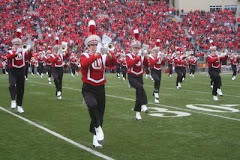This Wednesday evening begins the Jewish holiday of Passover. Some believe that passover is what happens when you're not called for jury duty; but in actuality it is a major religious holiday commemorating not only the passage of the ancient Hebrews out of Egypt, but also the forty years spent constipated eating matzo while roaming around the desert waiting for Moses to ask directions to the Holy Land. Guys asking for directions is like a country road without dirt. If his sister Miriam had been in charge, the sojourn would have ended after a fortnight at best.
The main staple of food during Passover is matzo. Plain matzo can stop a tank in its tracks. Had they used matzo instead of simple Pennsylvania earth to shore up the dam, not only would Johnstown have remained flood free, but the dam itself would now be harder than uncut diamonds. This biblical food is so indigestible that gravel has an easier time flowing through the human digestive tract. Advanced Imodium is like gobbling down a carton of prunes and washing it down with EX-Lax compared to a box of matzo. I think Kevlar jackets have a matzo lining. But matzo is the traditional food. The days following the end of Passover are the busiest times of the year for proctologists. Go figure.
Like all Jewish holidays, Passover revolves around prayer, self-contemplation and food. Most non-religious Jews passover the first two principles rather guiltily, but make up for their sectarian lapses by pigging out (perhaps a bad choice of words) under the third category. Hundreds of years ago, some wise sage summed up all of Jewish history with this pithy remark: "Somebody wants to kill the Jews; the Jews survive; let's eat."
Passover is a holiday so old it takes up Chapters 1-15 in Exodus and is then recapped again in Leviticus 23. On the first and second nights of this eight day holiday a 150 course meal, featuring lamb, soups, briskets, Kugel, cakes, candies (no leavening please) and other cardiologists' nightmares, is served. This is to commemorate the fact that the slaves had scant time to sit around eating sand and dung beetle sandwiches when Moses gave the word to roll on out of Egypt. Grab what you can and leave the rest for Goodwill. This heart-stopping meal is called the Seder.
Girding oneself for these two nights takes weeks of stomach expansion exercises and calorie destroying calisthenics. A new liver is advised, for drinking at this meal is as mandatory as knowing that the serving of food will only end when all arteries are clogged and the paramedics arrive with crash carts.
The Passover wine is so sweet that pure cane sugar could develop diabetes from it. So arduous is the preparation for the Seder that no sooner are the dishes washed and the crowds dispersed than planning begins for the following year. It takes that long just to make sure those who hate each other are seated right next to each other again.
Now Seder in Hebrew means order. People just doesn't get together and begin scarfing down food. That would then make it a wedding or a wake. Tradition demands an order to the serving of the meal. That's where the Haggadah comes in. This ancient text sets down the rabbinical codification of when to serve which dish, how to relax while eating it, what questions children should ask, and what answers no one pays any attention to.
The Haggadah also lays out when to drink the wine, sing songs about goats and, in more modern versions, when to leave your seat to disrupt the ongoing service by talking loudly to others about how poorly your children are turning out. Fun and guilt are had by all.
 Various beautifully illustrated Haggadah editions from all over the world have survived through the centuries and now safely reside in various university special collections. One of the most magnificent examples of extraordinary artistry is that created by Arthur Syzk. His Haggadah is possibly the most widely distributed version of the Twentieth Century. The illustration on the left depicts Pharaoh's men drowning in the Red Sea. Remember, the Bible isn't a series of Comedy Central one-liners.
Various beautifully illustrated Haggadah editions from all over the world have survived through the centuries and now safely reside in various university special collections. One of the most magnificent examples of extraordinary artistry is that created by Arthur Syzk. His Haggadah is possibly the most widely distributed version of the Twentieth Century. The illustration on the left depicts Pharaoh's men drowning in the Red Sea. Remember, the Bible isn't a series of Comedy Central one-liners.While the Haggadah is an important book, it is not writ sacred. Any participant can add personal and relevant passages to his or her own Haggadah ,as long as the basic line of the ceremony is kept intact. Feminist, gay and lesbian tracts, blessings for our soldiers in Iraq and Afghanistan, and various and sundry political statements have crept into current texts. What never seems to change, regardless of the author, is the amount of food and drink that inherently must be consumed.
Thanks to friends, I stumbled upon this latest version of the Haggadah . I doubt it will end up in any hermetically sealed cabinets, but it certainly does have that feel to it: Moses is Departing Egypt: A Facebook Haggadah.
Hundreds of Haggadah variations are now circulating on the Internet. No doubt there is even an Al Qaeda Haggadah someplace out there with some verse about "Death to the Jews" and "Next Year in Jerusalem or Else." If they drink as much wine during their Seder as is required by Haggadah bylaws, I doubt if any of them will remember their chants the next day, let alone their way back through the Khyber Pass.
















